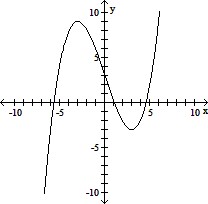Solve using the multiplication principle. =
=  x
x
A. 
B. 84
C. 
D. 
Answer: C
You might also like to view...
Find the Taylor polynomial of order 3 based at a for the given function. ; a = -1
; a = -1
A. -  +
+  (x + 1) -
(x + 1) -  (x + 1)2 +
(x + 1)2 +  (x + 1)3
(x + 1)3
B. -  +
+  (x + 1) -
(x + 1) -  (x + 1)2 +
(x + 1)2 +  (x + 1)3
(x + 1)3
C. -  +
+  (x + 1) -
(x + 1) -  (x + 1)2 +
(x + 1)2 +  (x + 1)3
(x + 1)3
D. -  +
+  (x + 1) -
(x + 1) -  (x + 1)2 +
(x + 1)2 +  (x + 1)3
(x + 1)3
Use the graph of the function f(x) to locate the local extrema and identify the intervals where the function is concave up and concave down.
A. Local minimum at x = 3 ; local maximum at x = -3 ; concave up on (0, ?); concave down on (-?, 0) B. Local minimum at x = 3 ; local maximum at x = -3 ; concave down on (0, ?); concave up on (-?, 0) C. Local minimum at x = 3 ; local maximum at x = -3 ; concave up on (-?, -3) and (3, ?); concave down on (-3, 3) D. Local minimum at x = 3 ; local maximum at x = -3 ; concave down on (-?, -3) and (3, ?); concave up on (-3, 3)
Answer the question.Your true height is 70.4 inches. A tape measure that can be read to the nearest tenth of an inch gives your height as 70.5 inches. A second tape measure which can be read to the nearest eighth of an inch gives your height as 70 inches. Which of these two measurement is more precise? Which is more accurate?
inches. Which of these two measurement is more precise? Which is more accurate?
A. The first tape measure gives a more precise reading but the second tape measure gives a more accurate reading. B. The second tape measure gives a more precise reading and also a more accurate reading. C. The second tape measure gives a more precise reading but the first tape measure gives a more accurate reading. D. The first tape measure gives a more precise reading and also a more accurate reading.
Find the limit.

A. 1
B. 
C. 2
D. ?